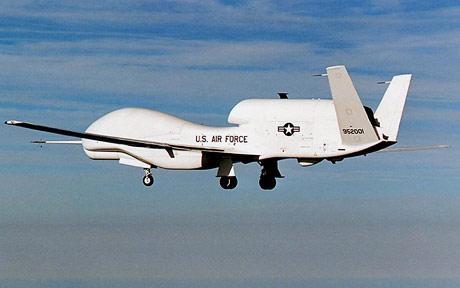Native Americans and the U.S. Military
With the 21st century on the horizon, the United States military can be expected to provide continuing opportunity for Native American men and women. For their part, Native Americans can be expected to carry on their centuries-old warrior tradition--serving with pride, courage, and distinction.
Predators, Warriors and Ravens: the CIA Drones Wage War
The CIA’s use of unmanned aircraft to kill insurgents and militants marks a turning point in the history of war
By Lara Marlowe
The only weaponised drone, and the star of the exhibition, is the Warrior, a souped-up Predator that carries four laser-guided Hellfire missiles under its wings. The army calls it the Grey Eagle. “There are rules in army aviation that you have to have a North American Indian chief or tribe name,” says Lt Col Kevin Messer.
Predator drones have been used extensively by the CIA to assassinate alleged al-Qaeda and Taliban militants in the tribal areas of northwest Pakistan. The army uses drones mostly in what it calls TIC (troops in combat) incidents.
So according to the US military, Warriors are equivalent to Predators, which are equivalent to Indians. Could it be any clearer what the Army thinks? Grey Eagle, Indian, warrior, predator, lion, tiger, bear...they may not make great scientists or diplomats, but they sure make great killers.
As the child said when explaining his school mascot, "We simply chose an Indian as the emblem. We could have just as easily chosen any uncivilized animal." This kid could've been a military planner instead of an eighth grader.
These drones are mindless killing machines that pursue enemies relentlessly and mercilessly. Not coincidentally, that's how many Americans view Indians. So a weaponized drone is the military equivalent of an Indian savage. Recognizing this, the Army names the drones after the savages.
Americans also like to think of their sports teams as mindless killing machines that pursue enemies relentlessly and mercilessly. So they give their teams the same names: Redskins, Apaches, Chiefs, Warriors, Braves, Eagles, Wolves, Lions, Tigers, Bears. They're all savages, marauders, predators--ready to do or die, kill or be killed, etc. Nice.
For more on the subject, see Indians in the Military and Smashing People: The "Honor" of Being an Athlete.
Below: A savage Grey Eagle Predator drone, I presume.


4 comments:
Actually, I think that is more of an "honor" than a sport teams mascot. Here's why--
The U.S. Military does not have a mascot. Nor do they play dress up as "injuns" on the battlefield.
Secondly, they name their highly advanced war technologies after Native American Tribes or Chiefs. Which means they favor Native Americans names over that of Cowboys and Settlers.
And as for the "mindless killing machines" bit, I think that's more of an exaggeration on Rob's part(as usual). If the Native was a "mindless killing machine" on field of sports, we would be seeing the many deaths of whites sportsmen don't you think?. Simply put--if Natives were actually "mindless killing machines" in our history, certainly, we would be victorous on the battlefield? I like to think so.
~GENO~
Actually, it is an honor. I mean, I have yet to see a soldier doing a war dance for the other soldiers. Or even for recruitment.
The military actually likes Indians. And not just because Indians serve disproportionately.
Also, the drones aren't "mindless" any more than a helicopter is; there's a puppet master behind all technology. For now.
No, throwing bodies into a battle without regard for life or death isn't a recipe for military success. Most victories depend on the brains of the commanders, not the brawn of the soldiers.
"Killing machine" is obviously a metaphor in a sports context, Geno. It's called poetic license.
A drone is "mindless" in the sense that once you activate it, it seeks out and kills its quarry without further input. That's different from a helicopter or other manned machine, where humans can choose whether to act until the last moment.
If the military likes Indians so much, why doesn't it name its aircraft carriers and battleships for them? And name its killer drones for US presidents and other "great white fathers"?
America uses its weaponized drones for "targeted killings"--i.e., cold-blooded assassinations. Who thinks being associated with that is an honor?
http://www.cnn.com/2010/US/06/02/un.targeted.killings.report/index.html?hpt=T2
U.S. is world's top user of targeted killings, U.N. says
The United States was identified Wednesday as the world's No. 1 user of targeted killings -- largely as a result of its dependence on unmanned drone attacks in Pakistan and Afghanistan.
A report released by the United Nations called the drone attacks part of a "strongly asserted but ill-defined license to kill without accountability" and warned that they are contributing to an erosion of longstanding international rules governing warfare. It urged states to identify publicly the rules of international law believed to provide a basis for any attempted targeted killings as well as the rationale for deciding to kill instead of capture individuals.
Post a Comment